| Castle Campbell is accessed from a lovely little village called
Dollar in Clackmannanshire. Built where the burns of Care and Sorrow join and
overlooked by Gloom Hill, it was originally known as "Gloom
Castle". This is a far cry from the sight which greets the visitor. A steep
narrow road will take you to the top of the hill where Castle Campbell looks out
on to the Pentland Hills and the village. It is peaceful and breathtaking, one
of the best settings that I have seen. The site on which it stands was probably
fortified from the Middle Ages. |
 |
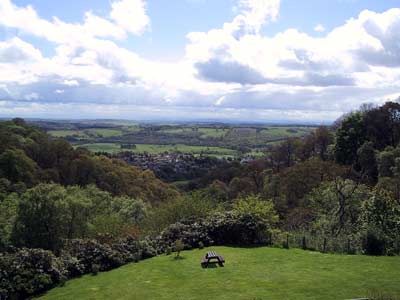 |
| Once a property of the Bishop of Dunkeld and held by the
Stewarts of Innermeath, the castle passed through inheritance in 1481 to Colin
Campbell, 1st Earl of Argyll and Chancellor of Scotland, after which its name
was changed to Castle Campbell by Act of Parliament in 1489. Cromwell's forces
occupied the castle in 1653,and it was torched by General Monck in 1654. In 1948
the castle was taken over
by the National Trust for Scotland, and is now administered by Historic
Scotland. |
| Click here to see an illustration of the castle as it would have looked |
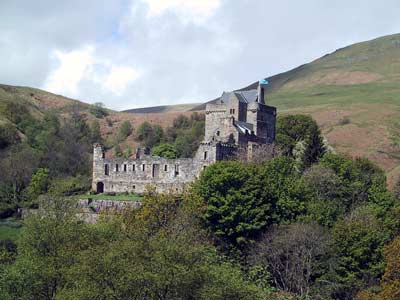 |
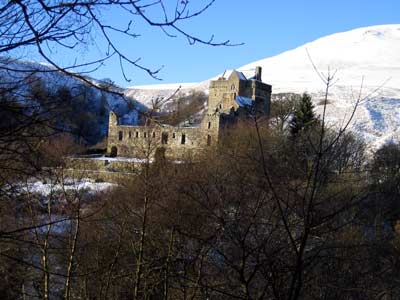 |
| The tower house was built in the 15th century, while the
southern ranges were added over the following two centuries. Castle Campbell was the
lowland seat of Archibald Campbell, Earl of Argyll, a prominent of Mary, Queen
of Scots' Privy Council. Argyll married Lady Jean Stewart, Mary's half-sister
and close confidante. |
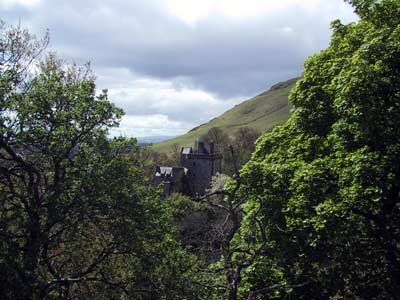 |
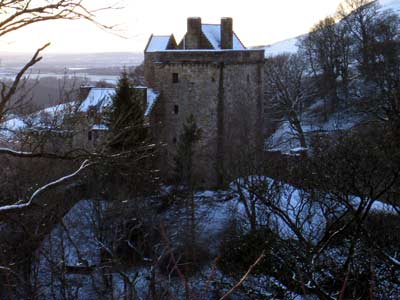 |
Click HERE to continue the visit...
| Mary
was here from 9th to 12th January 1563 attending the wedding of Argyll's sister
to James Stewart, Lord Doune.She had just returned from her punitive
expedition against Lord Huntly in the Highlands. There were masques and banquets
during those festivities in which Mary took part, little knowing that two years
later, the Earl of Argyll would join the rebellion against her and Darnley in
protest of their own marriage. Moray was particularly annoyed with Mary because
such a match destroyed his own ambitions to the throne, while the rest of the
Scottish nobility opposed it because it advanced the house of Lennox at the
expense of other rival factions. On 18th July 1565, Moray and others met
secretly at Stirling to formulate a request to Elizabeth for military
intervention. However, getting wind of what was being conspired against her,
Mary decided to bring forward the date of her marriage. On 22nd July she
mobilised her subjects to withstand a possible invasion, and created Darnley
Duke of Albany. The banns of marriage were proclaimed simultaneously in St Giles
and the Chapel Royal. On the evening of 28th July, a proclamation was read at
the Mercat Cross, stating that Prince Henry, Duke of Albany, was henceforth to
be named as King. This was an illegal act without the advice and consent of her
Council and the Estates. Mary and Darnley were married on 29th July, and shortly
after, she took decisive action against her rebellious brother. The Council
issued a summons to Moray to appear before them within six days, while Ch‚telherault
and Argyll were ordered not to assist him. Moray withdrew to Argyll hoping for
an English intervention. But Elizabeth was loath to send military assistance to
a rebellion which did not have the backing of the common people. Among those on
Moray's side were: the earls of Argyll, Rothes and Glencairn, Ch‚telherault,
Lords Boyd and Ochiltree and General Kirkcaldy of Grange. Mary's supporters were
her father-in-law, the Earl of Lennox, the earls of Atholl, Caithness, Erroll,
Montrose, Cassilis and Home, Lords Fleming, Lindsay and Ruthven, her
half-brother, Lord Robert Stewart, the Earl of Morton and Lord George Gordon.
The latter had now been released from prison after the Huntly affair and hating
Moray more than anything, was only too happy to dish out revenge. Bothwell too,
who had been recalled from exile in France after the Arran affair, was a staunch
enemy of Moray. |
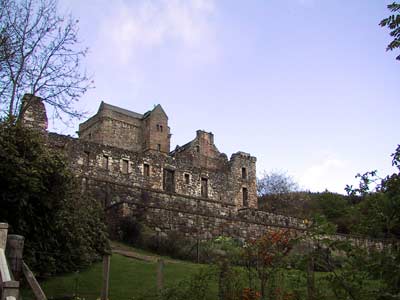 |
| On 15th August, the rebels began mobilising near Ayr, with the
intention of attacking nine days later. Mary then issued a summons on 22 August
calling up the men of the middle shires. On the 26th she left Edinburgh for
Linlithgow with a force consisting of 600 arquebusiers and 200 spearmen. By the
time she reached Glasgow, her army had swollen to over 5,000 men. Moray and Ch‚telherault
entered Edinburgh on the 31st with 1,200 horsemen. Argyll was expected to join
them there two days later with a similar number. Moray's intention was to
control the capital, raise as many recruits from the townspeople, and hold out
until a force of 400 English arquebusiers landed at Leith. However, the people
of Edinburgh remained loyal to Mary, English help did not arrive, and John
Erskine, Earl of Mar, held Edinburgh Castle in the Queen's name. As the castle's
guns began to bombard the city, Moray sent a letter to his sister begging her to
lay off while he surrendered to the Council. But Mary would have none of it and
made rapid progress towards Edinburgh. Meanwhile, Moray fled on 2nd September
and made his way to Dumfries still hoping for English assistance. Mary went back
to Glasgow via Stirling to monitor the movements of Argyll, but then returned to
Edinburgh at the end of the month to organise a much larger army to deal with a
possible invasion from the south. It is during this month that, passing close by
Castle Campbell, Mary received the surrender of the castle. Elizabeth, while
hinting that she might help the rebels, was far too worried about Mary enlisting
the help of France and Spain. So, as Mary advanced on Dumfries with an even
larger force augmented by Lord Huntly's Gordons from the north-east, and
Bothwell's men from the Borders, the leaders of the rebels fled to England. With
his tail between his legs, Moray accepted Elizabeth's remonstrance for the sake
of asylum. So ended what is known to history as the "Chaseabout Raid". |
 |

|
| The hall (above left) was the principal room at the centre of the range. It
probably rose the full height of the range above the basement, covered by an
open timber roof. There was a fireplace at the centre of the north wall, and
there may have been another for the High Table at the east end. There was
probably a timber draught screen at the west end, where the main entrance was
situated. The hall was later reduced in size to allow the insertion of more
chambers at the east end. |
| Open all year but not Thursdays pm and Fridays from October to March. Tel.:44+ (0)1259 742 408. |








